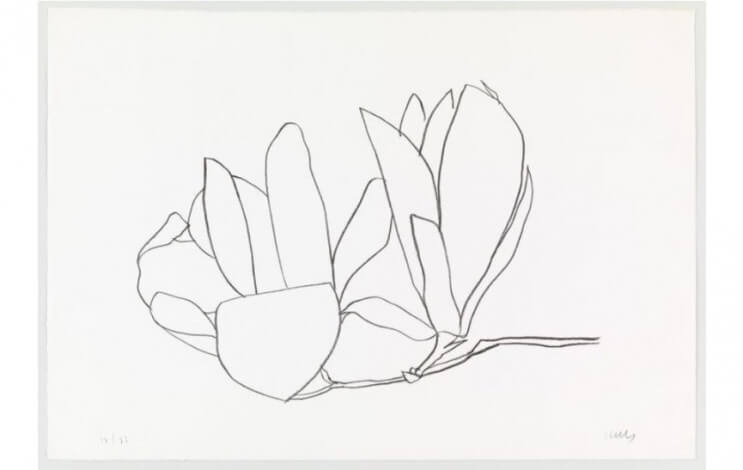
Abstraction and Nature in Ellsworth Kelly Paintings
When an artist becomes famous for making a particular type of work, prime examples of that type of work tend to become the most valuable pieces in the artist’s oeuvre. Perhaps that’s why so many of the Ellsworth Kelly paintings we find in museum collections exemplify the odd-shaped, monochromatic works Kelly made. Casual observers may assume that’s the only type of art Kelly created. They might also assume that the meaning of these pieces is purely abstract. Kelly’s monochromes could easily be taken for expressions of geometric abstraction, hard-edge painting, conceptual art, color-field art or Minimalism. And while some of those tendencies may indeed have influenced Kelly at some point in his career, it would be more accurate to say that the artists working in those fields were influenced by him. Kelly was an innovator. And unbeknownst to many, his paintings weren’t purely abstract, but were representations of forms he found in nature.
Ellsworth Kelly’s Natural Roots
Kelly was raised with a personal connection to nature. He was born in 1923 in the idyllic Hudson River town of Newburgh, New York, 60 miles north of Manhattan. Surrounded by woods, rolling hills and the river he developed an early appreciation for the plants and animals of the neighboring wilderness. After studying art and design at Pratt for two years, Kelly enlisted into the army. Along with several other artists Kelly was part of the Ghost Army in World War II, a unit for which he was particularly well suited, as its role was to conceive and execute camouflage operations to mislead enemy troops in the European countryside.

Ellsworth Kelly - pencil drawing of the Tuileries Garden, Paris, 1949
After the war, Kelly spent a number of years in Paris continuing his art education. Although his early interest was in figurative painters, he soon noticed that his personal aesthetic interest wasn’t in ornate figurative work at all, nor was it even necessarily in painting. Rather, he found himself attracted to the simple shapes of the objects he saw around him. He made basic sketches of forms that interested him such as windows, architectural elements, and various natural elements such as flowers, shrubs, trees, leaves and fruit.
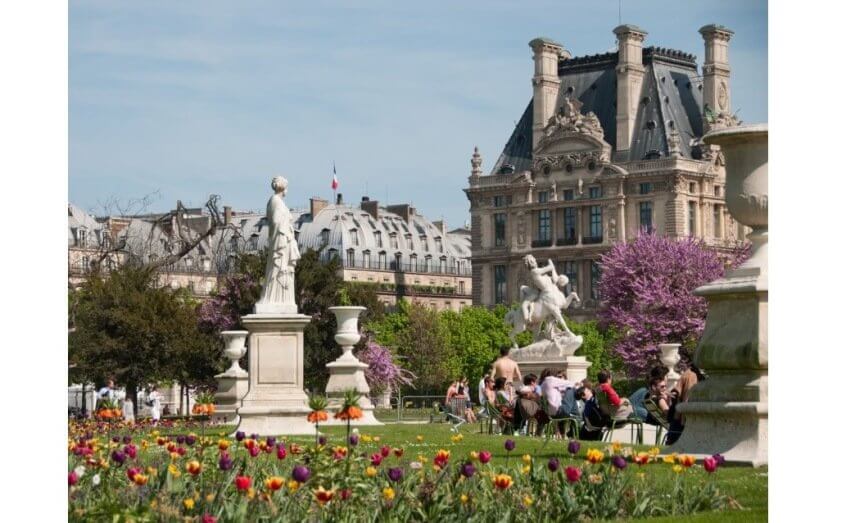 The Tuileries Garden today
The Tuileries Garden today
Ellsworth Kelly Drawings
Whatever subject matter he sketched, Kelly reduced the objects of his interest to their simplest forms. He made studies of the forms and began expressing them in his art. Throughout his career, the sketches he made early in his life inspired a tremendous number of paintings, sculptures, screen prints and other aesthetic objects. Though the works he made are often perceived as being emotionless, Minimalist abstractions of meaningless forms, the truth is that they reference a specific, real world language of natural shapes by which Kelly was inspired.
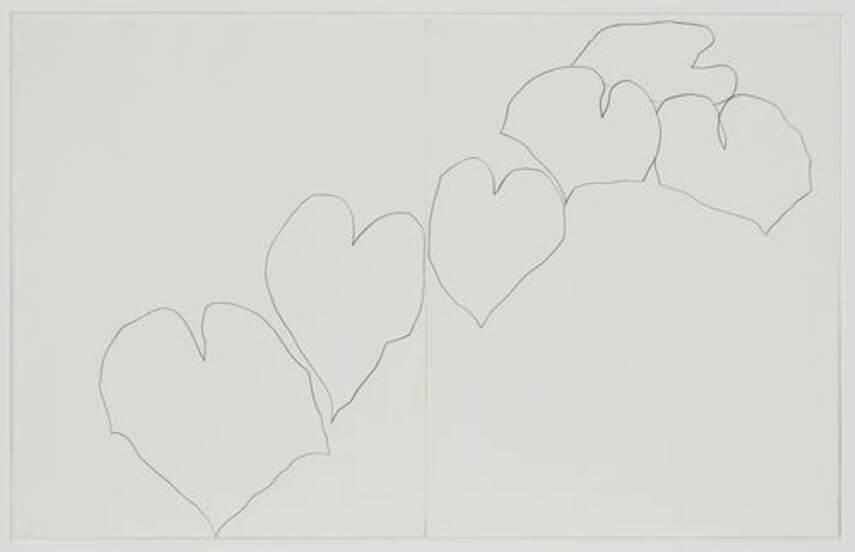
Ellsworth Kelly - Wild Grape, 1960, Pencil on two sheets of paper, 28 1/2 x 45 in, MoMA Collection
In the 1960s he made a series of drawings of various wild fruits, garden vegetables, trees, branches and the leaves and flowers of various other plants. His 1960 drawing titled Wild Grape reduces the leaves of the wild grape plant to their simplest forms. In his 1962 painting Red White, Kelly takes that exact form and inverts it onto a white canvas.

Ellsworth Kelly - Red White, 1962, Oil on canvas, 80 1/8 x 90 1/4 in., SFMOMA Collection
In his 1965 drawing Grapefruit (shown below as a lithograph), Kelly reduces the image of a ripe grapefruit and several leaves dangling from a branch. The conglomeration of shapes and the conceptual range of colors represented by these elements manifests that same year in his lithograph Blue and Yellow and Red-Orange.
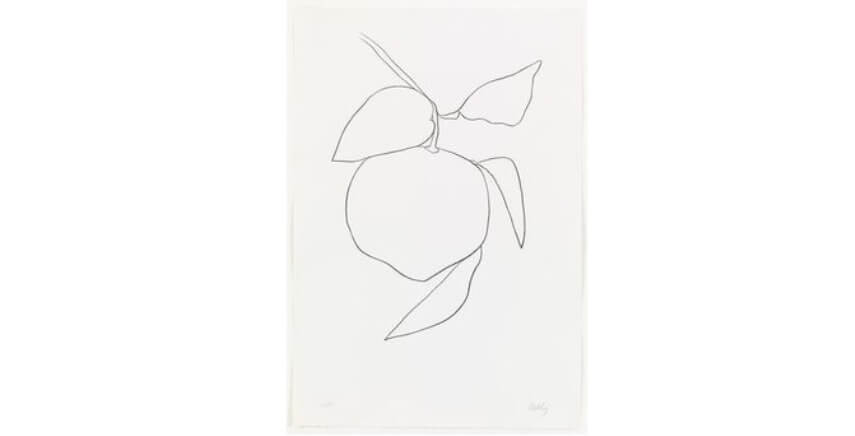
Ellsworth Kelly - Grapefruit (Pamplemousse), 1965, One from a series of twelve lithographs, 23 7/16 x 20 in., MoMA Collection
Another one of Kelly’s interests was in the viewer’s relationship to the space in which art is presented. In his quest to address this aspect of the aesthetic experience, Kelly made the breakthrough in his work that would lead to the iconic visual style that made him famous: shaped, monochromatic objects that hang on the wall. These objects weren’t really paintings; they were more sculptural in nature, a distinction considered irrelevant by Kelly. An early example of this type of work is Yellow Piece. The form of the piece is a mature expression of the combination of his natural inspirations and the process of creating manufactured aesthetic phenomena.
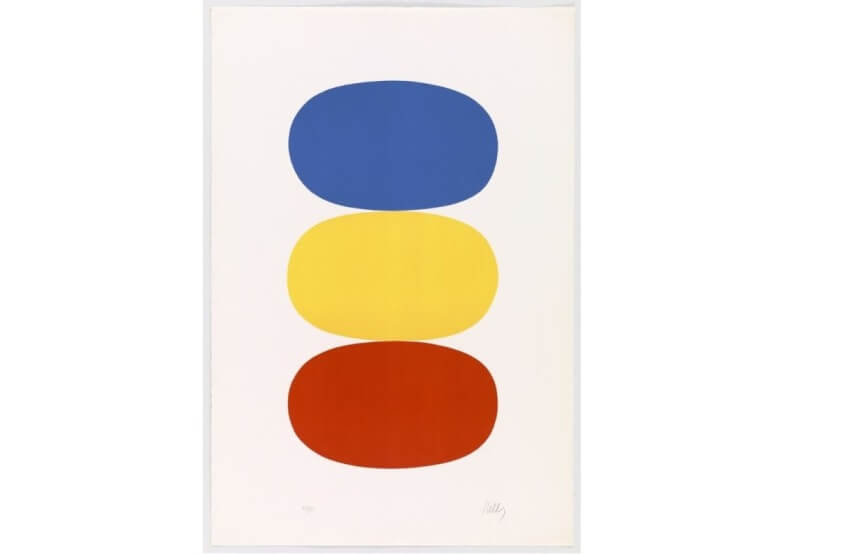
Ellsworth Kelly - Blue and Yellow and Red-Orange (Bleu et jaune et rouge-orange), 1965, Lithograph, 25 3/8 x 13 13/16 in.
Ellsworth Kelly Paintings
Yellow Piece, along with Kelly’s other shaped works, represents a major conceptual leap. By shaping the canvas Kelly re-contextualized the wall and the surrounding architecture. Rather than the canvas acting as a background for an image, the wall itself became the support for the work. Rather than being a disengaged, ambient environment in which art is viewed, the architecture became an integral part of the viewer’s experience. In this way Kelly perfectly expressed his inspiration. He made the gallery a natural environment. His art was part of the environment, growing out of it, supported by it, enhanced by it and enhancing it. Viewers encountered it in the same way they might encounter a leaf, a flower, a stem or any other natural element in a garden or a field.
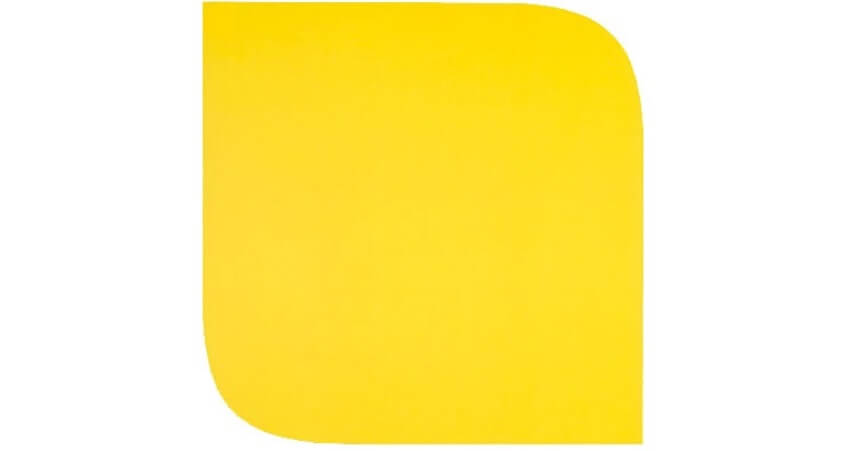
Ellsworth Kelly - Yellow Piece, 1966, Synthetic polymer paint on canvas, 75 x 75 in.
Some of his shaped pieces even further extended his exploration into spatial aesthetic relationships by introducing a sort of layered, collage-like element. These so-called “relief” works were layered, multi-paneled objects that combined dimensionality with shaped canvases. These pieces extend outward into the space between the object and the viewer, inviting a personal, almost anthropomorphic relationship to emerge between the viewer and the work of art. Integral to this relationship is the question of what the formal differences truly are between the viewer and the work.
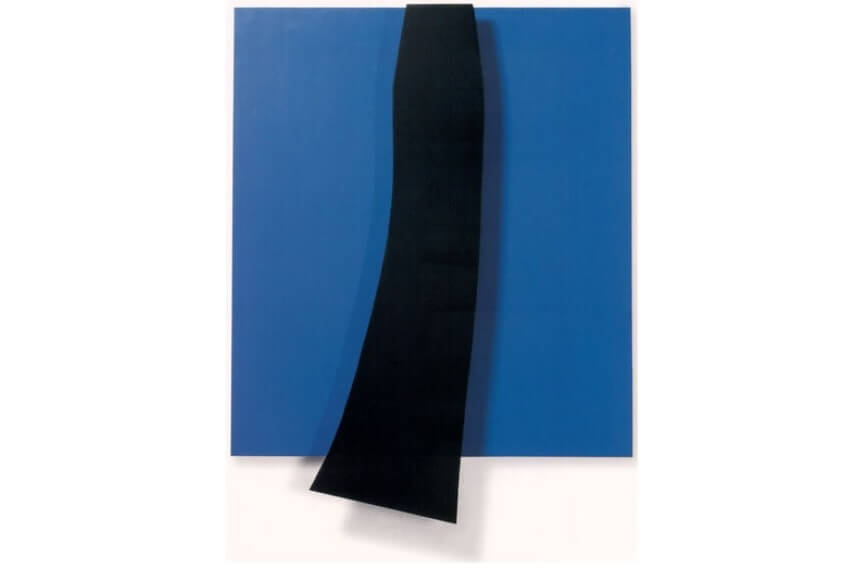
Ellsworth Kelly - Black over Blue, 1963, Painted aluminum, 81 ¾ x 64 ¼ in. x 6 in, SFMOMA Collection
Sculptures
Kelly was also a prolific maker of traditional sculptural objects. His sculptures follow the same aesthetic language as his other works, referencing the natural forms and compositions that appear in so many of his nature sketches. In Kelly’s 2002 sculpture White Curves we see the reappearance of the form of a single petal of a magnolia flower, as captured in his 1966 lithograph Magnolia.

Ellsworth Kelly - White Curves, 2002, White aluminium, Located in the sculpture garden of the Fondation Beyeler, Riehen, Switzerland
Next time you encounter the work of Ellsworth Kelly, consider it from the viewpoint of the inspiration he himself expressed. Rather than interacting with his works as though they are emotionless, purely abstract geometric objects, consider them an expression of the visual language of nature that exists all around us. As Kelly said, “drawing plants has always led me into my paintings and my sculptures. All my work comes from perceiving. I'm not a geometric artist.”
Featured Image: Ellsworth Kelly Magnolia,1966, Lithograph,24 1/4 x 34 3/4" All images © Ellsworth Kelly, all images used for illustrative purposes only
By Phillip Barcio






